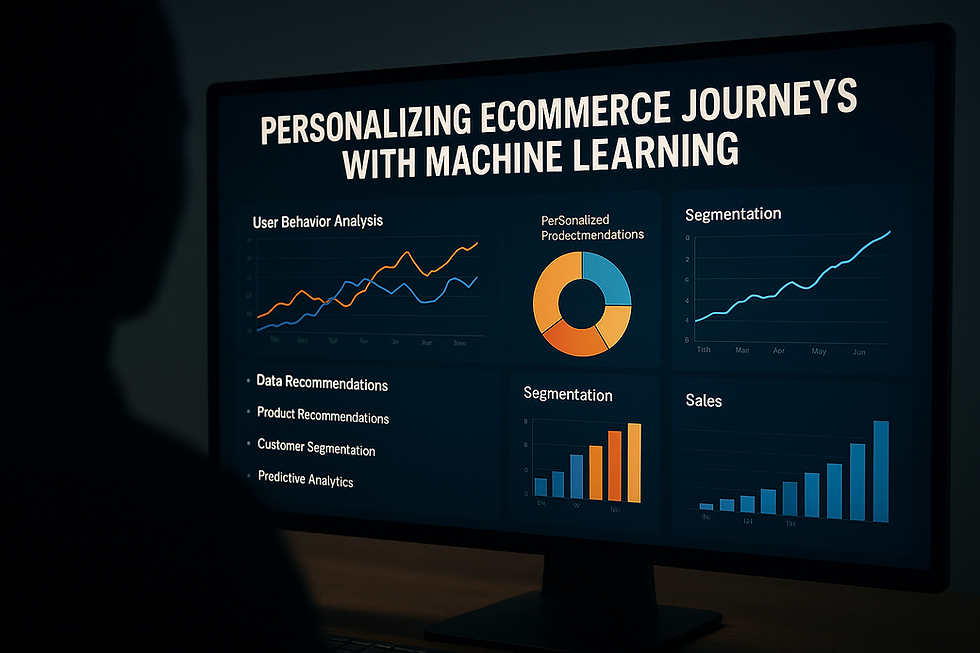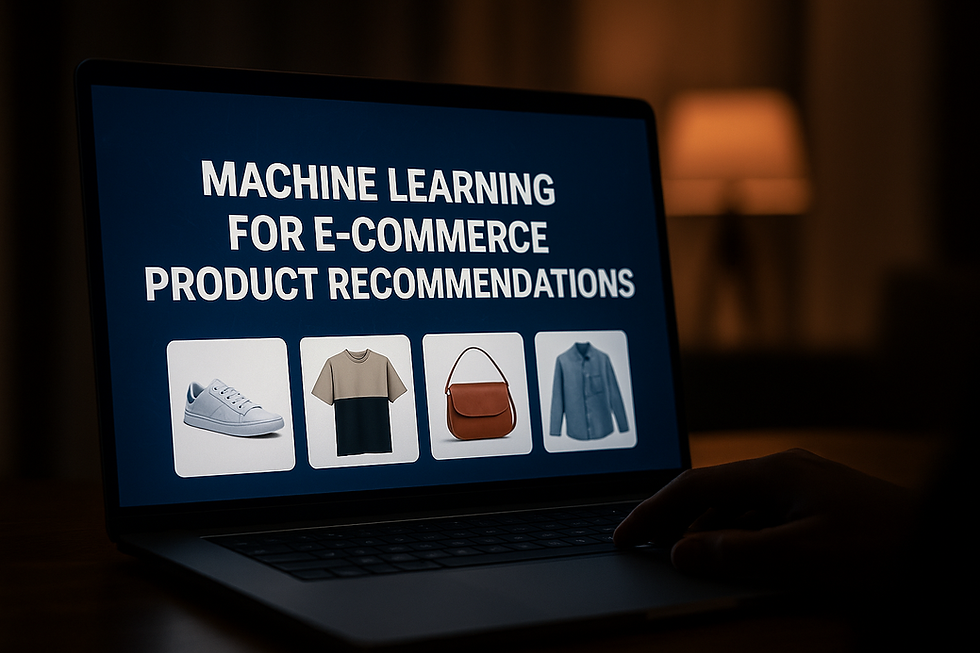Personalizing Ecommerce Sales Journeys with Machine Learning
- Muiz As-Siddeeqi

- Aug 19
- 5 min read

Personalizing Ecommerce Sales Journeys with Machine Learning
They didn’t leave your site because your products were bad.
They left because the experience wasn’t theirs.
They browsed. You showed them what you thought was right.
They clicked. You guessed what might work next.
They left. You lost them.
This isn’t just another “conversion problem.”
It’s a personalization crisis.
And the only real solution that’s working today—documented, deployed, and delivering results across e-commerce giants and fast-growing challengers—is machine learning.
This blog isn’t theory. It’s about exactly how real businesses—like Sephora, Alibaba, ASOS, and Zalando—are radically transforming their ecommerce journeys, not with slogans, but with predictive models, behavior tracking, and ML-powered decision engines.
Let’s get into the full anatomy of how personalizing ecommerce sales journeys with machine learning is no longer optional—and why it’s the new frontline of e-commerce growth.
Bonus: Machine Learning in Sales: The Ultimate Guide to Transforming Revenue with Real-Time Intelligence
From Browsing to Buying: Why Personalization Isn’t Optional Anymore
The idea of personalization used to be simple. Show them what they might like based on what they bought last time. Basic filters. Manual tagging. Maybe a recommendation engine at best.
Today?
Ecommerce personalization has become a competitive survival mechanism.
According to a 2023 report by McKinsey, 71% of consumers now expect personalized interactions—and 76% get frustrated when they don’t receive them. And when they’re frustrated? They bounce. To competitors. To marketplaces. To alternatives that “get them.”
In fact, the same McKinsey report shows that companies that personalize effectively generate 40% more revenue from those efforts than those who don’t.
And guess what’s powering those personalized journeys?
Machine learning. Real-time. At scale.
Real Case: How Sephora Delivers Individualized Beauty Journeys
Let’s be specific.
Sephora, one of the most aggressive adopters of AI in ecommerce, uses machine learning to personalize everything from product recommendations to skin tone matching to dynamic content layouts.
They don’t just track clicks.
They monitor:
Skin tone preferences
Past purchases
Mobile interaction behavior
Wishlist patterns
Time-of-day purchase behaviors
And then?
They use ML-powered models to deliver hyper-personalized experiences—even changing homepage modules and app layouts per user.
Result?
According to LVMH’s annual report, Sephora saw a 30% boost in conversion rates from personalized digital efforts between 2021 and 2023.
Not speculation. Not theory. Documented impact.
The Machine Learning Pipeline Behind the Personalization Curtain
Let’s lift the hood. How does this really work?
Data Ingestion
User data is continuously collected across devices: clicks, scrolls, search history, purchase history, exit points, dwell time, session timings.
Feature Engineering
ML systems convert raw behavior into usable insights. For example:
“Visited skincare > 3 times this week” → Weightage = High intent
“Browsed luxury products, no cart” → Weightage = Price-sensitive intent
Segmentation with Clustering Models
Algorithms like K-Means, DBSCAN, or Gaussian Mixture Models group users into live segments: skincare lovers, discount hunters, last-minute buyers, etc.
Recommendation Models
Algorithms like Matrix Factorization, Collaborative Filtering, and more advanced Deep Learning architectures (e.g., recurrent neural networks) predict what each user is most likely to engage with.
Personalized UI/UX Rendering
The storefront adjusts. Not only products but banners, offers, layouts, and even colors (yes, A/B tested by ML) change to match the profile.
Real-time Feedback Loops
Every action updates the model. Every product clicked teaches the system. Every cart abandoned adds context.
This is not static personalization.
It’s living, learning, and adapting—every second.
Alibaba’s Real-Time Journey Mapping with Machine Learning
When you talk about scale, no one does ecommerce like Alibaba.
In 2022 alone, Alibaba handled 1.31 billion active annual consumers across its platforms.
How do you personalize journeys at that scale?
With real-time machine learning pipelines that handle petabytes of data.
According to a detailed technical paper published by Alibaba engineers in the proceedings of VLDB (Very Large Databases), they use a system called AIRec—a scalable deep learning recommendation engine.
AIRec dynamically adjusts product listings per user in milliseconds. It uses:
Graph Neural Networks (GNNs) for understanding item-user relationships
Attention mechanisms to focus on recent behaviors
Contextual bandits to A/B test thousands of versions per session
The impact? During Alibaba’s Singles’ Day 2021 campaign, personalized recommendations generated 31% higher click-through rates and 20% more purchases compared to static recommendations.
Beyond Recommendations: ASOS’s ML-Powered Journey Personalization
Most blogs stop at recommendations. But real ecommerce personalization is broader.
ASOS, the global fashion retailer, uses ML not just to recommend, but to reorder the shopping experience.
Their personalization efforts include:
Dynamic homepage layout based on gender, style preferences, time since last visit
“Complete the look” ML suggestions that analyze outfit patterns
Personalized delivery options based on ML predictions of preferred logistics (home delivery vs. locker vs. store)
ASOS’s Chief Data Officer, Clifford Cohen, confirmed in an industry panel in 2023 that these ML enhancements led to a 15% increase in repeat customer transactions and a 10% uplift in AOV (average order value).
That’s journey personalization. Not product pushing.
Hidden Moments: How Machine Learning Identifies “Micro-Journeys”
There’s another layer to this story—micro-journeys.
These are the small, almost invisible steps users take that often go unnoticed by humans—but get captured and mapped by ML.
For example:
Spending 7 seconds extra on a product photo
Zooming in twice on a size chart
Opening reviews but not reading the last 3
Visiting the same category 3 times without purchase
ML picks up these signals, correlates them across thousands or millions of sessions, and begins to see patterns that human marketers miss entirely.
This leads to next-level personalization:
Show a size guide reminder popup before cart
Trigger a discount on 3rd visit to the same product
Send a reminder when similar styles are restocked
These aren’t theoretical ideas. Shopify Plus brands like Allbirds and Gymshark implement such triggers using ML add-ons like Segment, Dynamic Yield, and custom data pipelines.
Reported Results: The Numbers Speak for Themselves
Still thinking ML personalization is “nice to have”? Here are hard numbers:
Deloitte (2024) found that brands using ML-driven personalization see an average 25% uplift in conversion rates across ecommerce sectors.
Accenture Interactive reports that 91% of consumers are more likely to shop with brands that remember their preferences and provide relevant offers.
Salesforce’s State of the Connected Customer 2023 showed that 68% of consumers expect brands to adapt experiences in real time, and that brands doing this have 2.4x higher customer loyalty.
Pitfalls and Ethics: Where Personalization Must Not Go
We also need to address the elephant in the room: creepy personalization.
ML can overstep. When users feel over-tracked, they bounce.
When they sense manipulation, trust collapses.
The solution? Transparent data use. Opt-ins. And designing ML journeys that serve the customer, not stalk them.
Top brands like Zalando and Nordstrom give users full control to adjust personalization settings, and even show “why am I seeing this?” buttons on recommendations.
That’s the balance: Smart ML. Ethical ML.
Wrapping It Up: The Machine Learns… and So Should We
Ecommerce is no longer about showing what’s available.
It’s about knowing what matters—to each person, right now.
Machine learning lets us do this—not in theory, but in practice.
From Sephora’s custom interfaces to Alibaba’s real-time rec engines… from ASOS’s journey mapping to Allbirds’ micro-interaction tracking…
The ecommerce battlefield has shifted.
It’s not about better prices. Not about wider catalogs.
It’s about who knows their customers—individually, intimately, instantly.
And the only way to do that?
Machine learning.

$50
Product Title
Product Details goes here with the simple product description and more information can be seen by clicking the see more button. Product Details goes here with the simple product description and more information can be seen by clicking the see more button

$50
Product Title
Product Details goes here with the simple product description and more information can be seen by clicking the see more button. Product Details goes here with the simple product description and more information can be seen by clicking the see more button.

$50
Product Title
Product Details goes here with the simple product description and more information can be seen by clicking the see more button. Product Details goes here with the simple product description and more information can be seen by clicking the see more button.






Comments